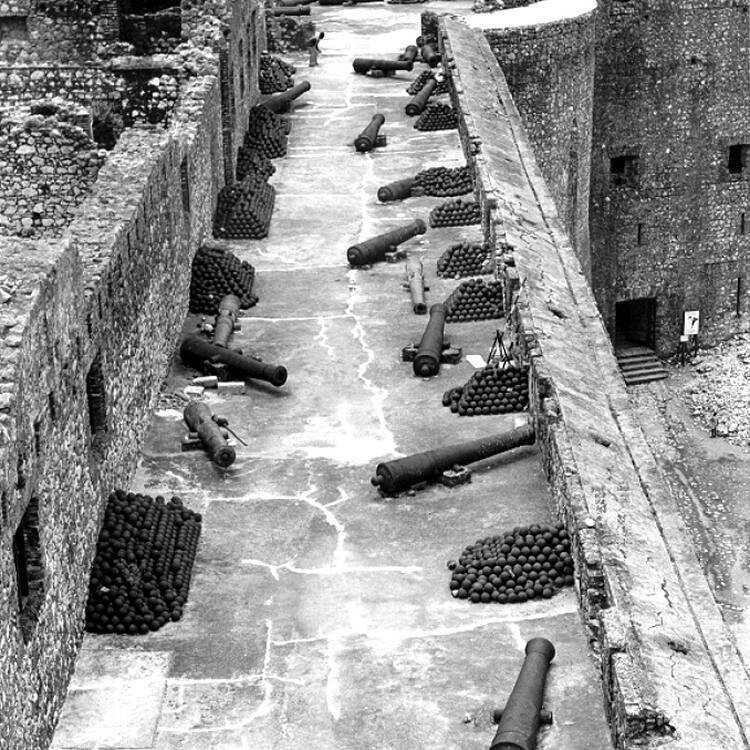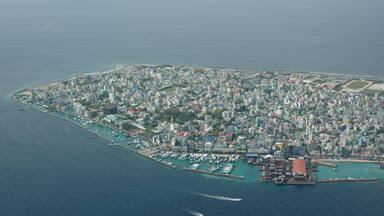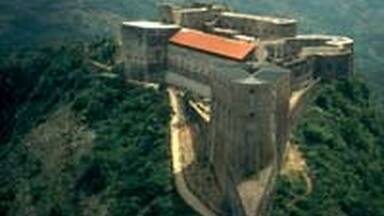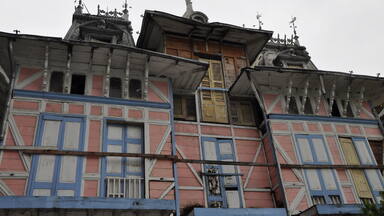National History Park – Citadel, Sans Souci, Ramiers
National History Park – Citadel, Sans Souci, Ramiers
These Haitian monuments date from the beginning of the 19th century, when Haiti proclaimed its independence. The Palace of Sans Souci, the buildings at Ramiers and, in particular, the Citadel serve as universal symbols of liberty, being the first monuments to be constructed by black slaves who had gained their freedom.
Description is available under license CC-BY-SA IGO 3.0
Parc national historique – Citadelle, Sans Souci, Ramiers
Ces monuments d’Haïti, le palais de Sans Souci, les bâtiments des Ramiers et tout particulièrement la Citadelle, qui remontent au début du XIXe siècle, époque où la République proclama son indépendance, sont chargés d’un symbolisme universel car ils sont les premiers à avoir été bâtis par des esclaves noirs ayant conquis leur liberté.
Description is available under license CC-BY-SA IGO 3.0
منتزه وطني تاريخي:القلعة، وقصر سان سوسي والمباني في رامييه
إنّ هذه النصب التاريخية في هايتي، أي قصر سان سوسي ومباني رامييه، لاسيما القلعة، العائدة للقرن التاسع عشر وهي حقبة أعلنت فيها الجمهورية استقلالها، تتّسم بقيم أخلاقية عالمية إذ أنها الأولى التي شيّدها قدامى العبيد بعدما استعادوا حريتهم.
source: UNESCO/CPE
Description is available under license CC-BY-SA IGO 3.0
国家历史公园:城堡、圣苏西宫、拉米尔斯堡垒
这些建筑可追溯到19世纪海地宣布独立的时期。圣苏西宫、拉米尔斯堡垒、尤其是古城堡对全世界来说都是自由的象征,因为它们是最先由获得自由的黑人奴隶修造的建筑。
source: UNESCO/CPE
Description is available under license CC-BY-SA IGO 3.0
Национальный исторический парк – Цитадель Ла-Ферьер, дворец Сан-Суси и укрепления Рамьер
Эти памятники датируются началом XIX в., когда Гаити провозгласило свою независимость. Дворец Сан-Суси, здания в Рамьере и Цитадель являются символами свободы, так как это были первые сооружения, воздвигнутые получившими свободу чернокожими рабами.
source: UNESCO/CPE
Description is available under license CC-BY-SA IGO 3.0
Parque Histórico Nacional – Ciudadela, Sans Souci y Ramiers
Estos monumentos datan de principios del siglo XIX, cuando Haití proclamó su independencia. El palacio de Sans Souci, los edificios de Ramiers y, en particular, la Ciudadela son símbolos universales de la libertad por ser los primeros construidos por esclavos negros que habían conquistado su emancipación.
source: UNESCO/CPE
Description is available under license CC-BY-SA IGO 3.0
国立歴史公園-シタデル、サン・スーシ、ラミエ
source: NFUAJ
Nationaal historisch park – Citadel, Sans Souci, Ramiers
Source: unesco.nl
Outstanding Universal Value
Bref synthesis
In the northern part of Haiti, the National History Park – Citadel, Sans-Souci, Ramiers (NHP-CSSR) is located in the central zone of the northern massif that extends to the Dominican Republic. The NHP-CSSR is located between the coastal plains and the mountainous interior of the region. The choice to build the Citadel on the summits responded to a strategy for interior protection, differing from the coastal defence strategy inherited from French colonization.
Created by presidential decree in 1978, to preserve the splendid natural scenery of the mountainous peaks covered with luxuriant vegetation, the NHP-CSSR covers an area of 25 km2. It includes the monumental ensemble of the Palace of Sans-Souci and its annex buildings, the Citadelle Henry and the Ramiers site, universal symbols of liberty, being the first monuments to be constructed by black slaves who had gained their freedom. For Haitians, they represent the first monuments of their independence.
On 1 January 1804, after fourteen years of struggle by the island’s black slaves against the colonists, Jean-Jacques Dessalines, the principal leader of the revolution, proclaimed the independent Republic of Haiti. The “Emperor” Dessalines immediately entrusted to one of his generals, Henri Christophe, the task of constructing an immense fortress on the Pic Laferrière, to protect the young republic.
Both military installation and political manifesto, the Citadelle Henry, constructed to a height of 970 m, is one of the best examples of the art of military engineering of the early 19th century. The plans are the work of the Haitian Henry Barré, but it is probable that General Christophe played the preponderant role in their formulation. The Citadelle Henry, covering an area of about one hectare, is a vast quadrilateral comprising four buildings protected by four flanking towers built around a central courtyard, and forming on several levels a bastioned front of batteries and barracks. The projecting masses, remarkably articulated to allow an integrated use of artillery capabilities, an elaborate system of water supply and cisterns, and colossal defensive walls render the citadel impregnable. It can shelter a garrison of 2000 men, or 5000 if necessary.
At the death of Dessalines, in 1806, the Republic of Haiti was divided into separate states : the southern part, governed by Pétion, and the north, where Christophe proclaimed himself king in 1811. The Citadelle Henry, originally conceived as a monument to the defence of liberty, was maintained as a fortress by the despot and was inaugurated in 1813.
At the same time, King Christophe (Henry 1) undertook the construction of an astonishing palace surrounded by gardens, situated at the foot of the access road to the Citadelle near to the village of Milot: the Palace Sans-Souci. This large architectural ensemble responded to the need to concentrate the essential administrative services of the new monarchy around the royal residence. Surrounded by mountainous peaks covered with luxurious vegetation, the Palace and its buildings were grouped in an amphitheatre covering an area of about eight hectares. The architectural ensemble comprised the royal residence, that is the Palace itself that Henry 1 used as principal residence until his death in 1820; the administrative buildings (State Council, Palace of Ministries, Royal Mint, library) ; the residence of the Crown Prince located to the west of the esplanade for official events; the stables, barracks, prisons, arsenal, various maintenance workshops, hospital, goldsmiths, etc. The ensemble was embellished with gardens, basins and fountains. Inaugurated in 1813, the Palace Sans-Souci was looted at the death of the king in 1820. Since then, abandoned, it was seriously damaged by the earthquake of 1842. Nevertheless, by its size, it remains an impressive and coherent ruin, owing its bizarre beauty to an exceptional harmony with the mountainous setting, as well as its recourse to diverse and yet reputedly irreconcilable architectural models. The Baroque staircase and the classical terraces, the stepped gardens reminiscent of Potsdam and Vienna, the canals and basins freely inspired by Versailles, impart an indefinable hallucinatory quality to the creation of the megalomaniac king.
The Ramiers site is a small plateau with sub-foundations and a some sections of wall of a residential ensemble protected by two pairs of fortified redoubts. The site commands a superb panorama and provides an unexpected view of the Citadelle, with its huge silhouette standing out against the empty skyline.
Unique testimonies directly connected to the independence of Haiti, resulting from a general uprising of slaves deported from Africa, are united here. The French Revolution of 1789 led to serious social upheavals in the Lesser Antilles, as in Santo Domingo. The most important was the slave revolt that resulted in 1793 with the abolition of slavery, decision endorsed and generalized throughout the French colonies by the National Convention six months later (First abolition of slavery, (le 16 pluviôse an II), [4 February, 1794]). At the end of a violent war, the Declaration of Independence of the country was proclaimed on 1 January 1804. The name « Haiti » (ancient name ‘taïno’ of the island before the arrival of the Europeans in 1492) was given to the country. Since then, Haiti remains the first state in the world resulting from a slave revolt.
Criterion (iv) : The National Historic Park - – Citadelle, Sans-Souci, Ramiers is an eminent example of a type of structure illustrating the historical situation of Haiti at the dawn of its independence.
Criterion (vi) : The ephemeral republic of Jean-Jacques Dessalines bears a universal historical significance: it is the first state founded in the contemporary epoch by black slaves who had won their liberty.
Integrity
The environmental context of the of the National Historic Park - Citadelle, Sans-Souci, Ramiers, still retains its original characteristics. The harmony of the landscape with the Dondon Valley and the surrounding hillocks, demonstrating a representative selection of the different environments of the region, constitutes a coherent human system. The topographical perception of axis between coastal and inland areas, justifying the occupation of this territory by the construction of these buildings, fortifications and palaces, is very strong.
Although damaged by the earthquake of 1842, the Citadelle Henry and the Ramiers fortifications conserve all their original coherence from both their built aspect and their military function.
Although looted at the death of Henry 1 and seriously damaged by the 1842 earthquake, the ruins of the Palace Sans-Souci largely conserve their essential and original architectural characteristics: general proportions, harmonious openings, significant architectural elements and details, component materials, etc.
However, important rainwater infiltrations constitute a threat to the precarious stability of the ruins, in particular the foundations.
The inscribed site is moreover mainly threatened by deforestation, subsistence agricuture, lack of central management and illegal urbanization of the towns of Milot and Dondon, adjacent to its boundaries. Disorganized tourism could also affect the integrity of the ruins of the Palace Sans-Souci.
Authenticity
The authenticity of the National Historic Park - Citadelle, Sans-Souci, Ramiers, is incontestable in terms of position and environment, spatial organization, form and conception, material and substance.
Implementation of an important intervention for protection against water infiltration of the ruins of the Citadelle Henry has been undertaken. This work, accomplished with technical assistance from UNESCO from 1979 to 1990, has preserved the integrity of the historic monument in accordance with Article 9 of the Venice Charter. Since 2013, the Institute for the Protection of National Heritage (ISPAN) has undertaken important works concerning the strengthening of the fragile parts of the work and improvements for visitor management.
Protection and management requirements
The National Historic Park - Citadelle, Sans-Souci, Ramiers is the property of the Republic of Haiti. The protection of the site is covered by the 1941 Law on the Protection of Monuments and Sites. The National Historic Park that protects the monumental zone of the Citadelle, the Palace Sans-Souci and the Ramiers Site was created by presidential decree of 1978. ISPAN, the specialized agency of Haiti, created in 1979, is the agency responsible for its administration.
The National Historic Park is directed by an Interministerial Management Council since 2013, comprising representatives of the six ministries, under the presidence of the Prime Minister of the government of the Republic. The permanent Secretariat of this Council is ensured by the Directorate General of ISPAN, the State focal point.
At the beginning of 2014, ISPAN established a temporary management structure, the principal mission of which was to prepare the Management Plan for the NHP-CSSR and the final structure for its management. The long term anticipated results are the implementation of the Management Plan; the development of the NHP-CSSR in accordance with the participatory and concerted plan; the stabilization and their protection from water infiltration of the historic monuments, and the development of cultural and tourism activities.
The clarification of the boundaries of the Historic Park by markers constitutes significant progress in the comprehension of the site and the preservation of its Outstanding Universal Value; however, additional work is required to define the buffer zone and establish adequate regulatory measures.










